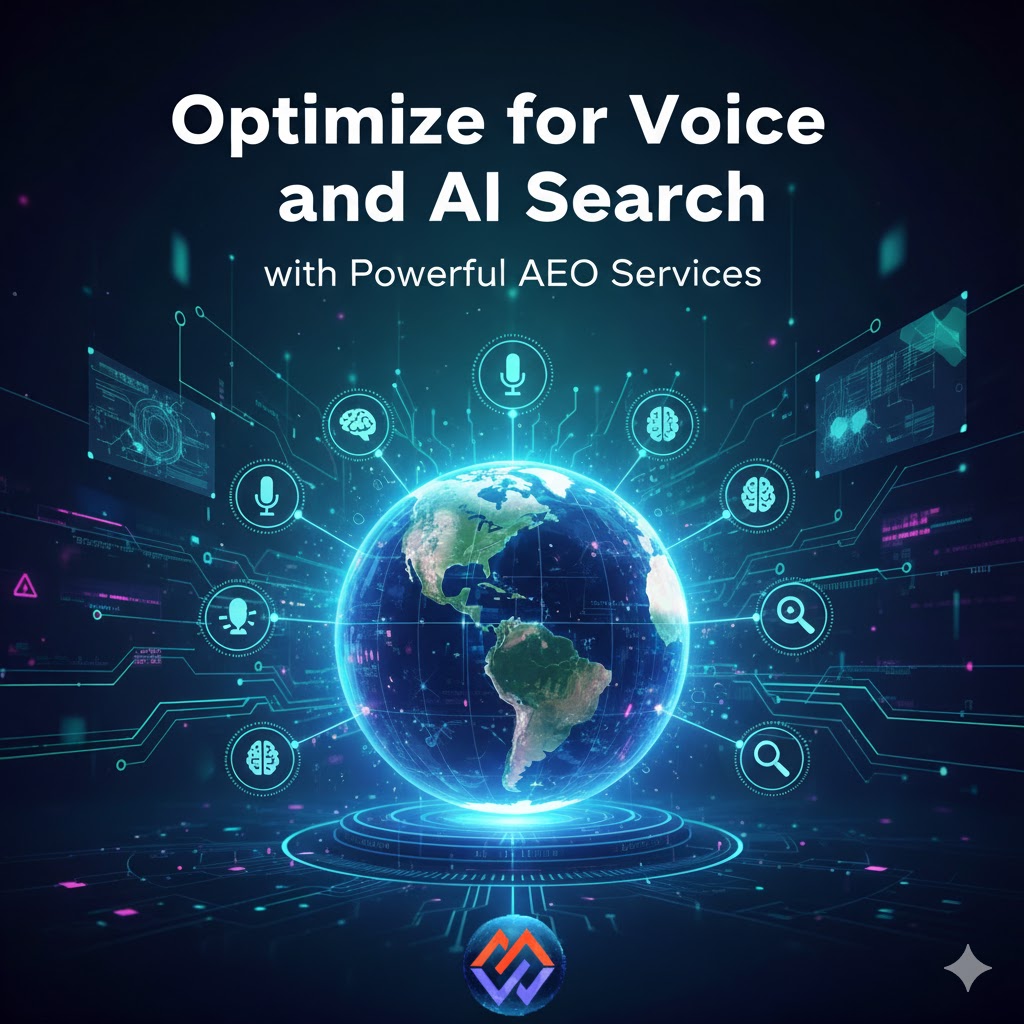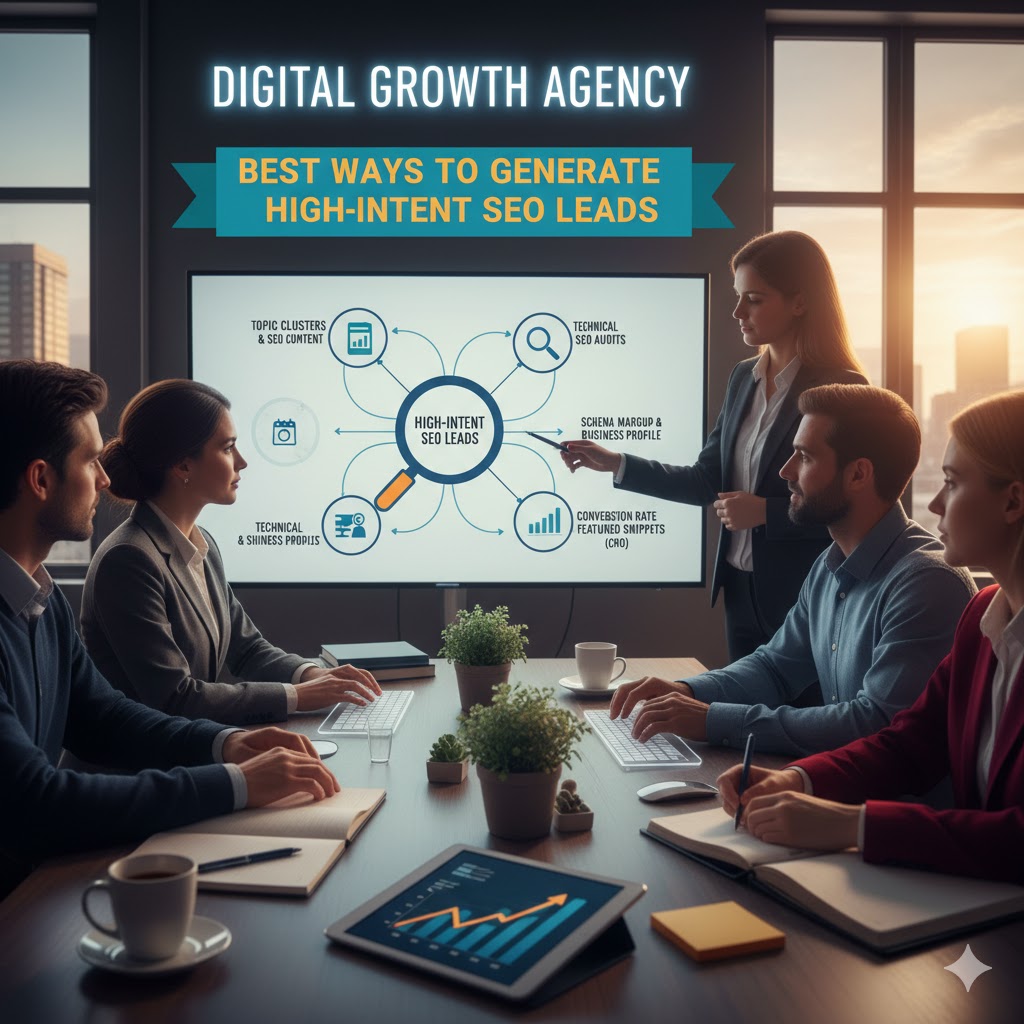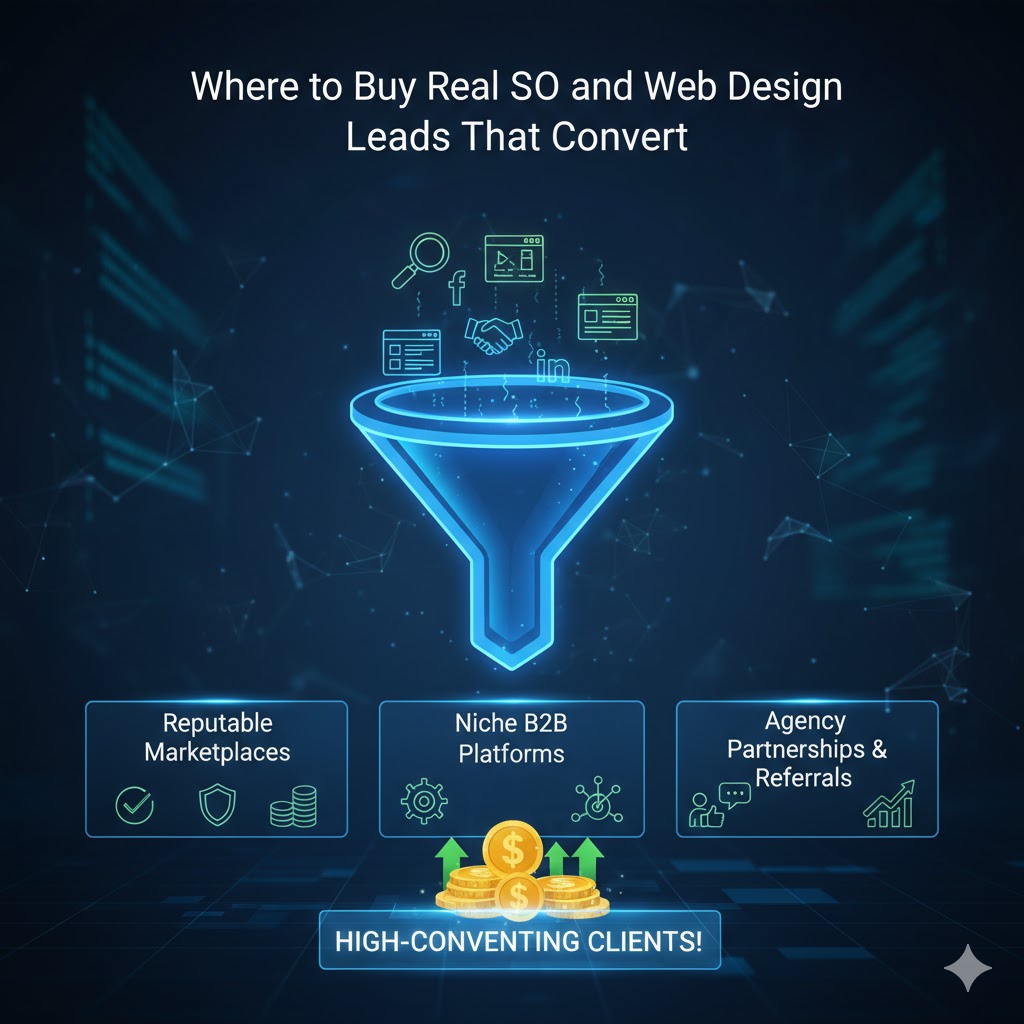As search behavior continues to evolve, users are increasingly turning to voice assistants and AI-powered tools like ChatGPT, Siri, and Google Assistant to find quick, accurate answers. This shift has given rise to a new approach in digital marketing — Answer Engine Optimization (AEO). Businesses that adapt early to AEO can significantly increase their visibility in voice and AI search results, making it easier for customers to find and trust them. What is Answer Engine Optimization (AEO)? Answer Engine Optimization focuses on optimizing your website and content so that it becomes the preferred source for AI and voice-driven search engines. Unlike traditional SEO, which targets search rankings on Google’s SERP, AEO aims to make your business the direct “spoken” or “generated” answer from AI tools. When someone asks their device, “What’s the best digital marketing service near me?” or “How can I grow my online business?” — AEO helps ensure your content is the one AI selects to deliver that answer. Why AEO Matters in Today’s Search Landscape With millions of users relying on AI and voice search daily, the way people interact with information has fundamentally changed. Instead of scanning multiple links, users want instant, conversational answers — and that’s where AEO comes in. Here’s why Answer Engine Optimization is essential:🎯 AI-Centric Discovery: AI systems like ChatGPT and voice assistants prefer structured, clear, and intent-based content.💡 Higher Visibility: AEO helps your brand become the top result that AI tools read or summarize aloud.📈 Improved Credibility: When your brand is chosen as an authoritative source by AI systems, trust and conversions naturally increase.🗣️ Voice Search Growth: As more people use hands-free devices, optimizing for natural, spoken queries ensures your business stays visible. Key AEO Strategies to Boost Your Online Presence 1. Optimize for Conversational and Long-Tail Queries Voice searches are usually longer and more natural. Instead of short keywords like “SEO services,” people ask, “Which company offers the best SEO services for small businesses?” Focus your content on answering these specific questions clearly and conversationally. 2. Structure Your Content for AI Readability AI systems favor content that is logically structured with headings, short paragraphs, and clear answers. Use FAQ-style sections and bullet points to make it easy for AI to extract concise, relevant information. 3. Implement Schema Markup Structured data is vital for AEO success. Schema markup helps AI and voice assistants understand your content’s meaning and relevance. Adding FAQ, Organization, and Local Business schema can improve your visibility in AI-driven answers. 4. Focus on E-E-A-T (Experience, Expertise, Authoritativeness, Trustworthiness) AI models prioritize credible sources. Build authority by showcasing certifications, real-world expertise, and original insights within your content. Cite reputable references and keep your information accurate and up to date. 5. Improve Page Load Speed and Mobile Optimization Voice and AI searches are often conducted on mobile devices. A fast-loading, mobile-optimized site ensures your answers are accessible and favored by AI algorithms. How AEO Works with Traditional SEO AEO doesn’t replace SEO — it enhances it. While SEO helps your content rank higher on search engines, AEO helps your content get chosen by AI-driven tools and voice assistants. Combining the two ensures your brand performs well across every digital platform. SEO focuses on search rankings.AEO focuses on answer rankings.Together, they build a powerful online presence that captures both organic and AI-generated traffic. How Website SEO Leads Helps You Master AEO At WebsiteSeoLeads, we specialize in optimizing businesses for the next generation of search — AI and voice-driven discovery. Our AEO services are designed to make your brand the trusted answer in conversational and generative searches. Here’s how we help:✅ Detailed content audits to identify AI-readiness gaps✅ Implementation of voice-friendly and structured content✅ Schema markup integration for enhanced AI comprehension✅ Ongoing AEO tracking and optimization reports Our team ensures your content is not only SEO-optimized but also AI-preferred — so your brand stays one step ahead in the evolving digital ecosystem. Ready to Be the Voice of Authority in AI Search? The future of digital discovery lies in AI and voice technology. If you want your business to remain visible, relevant, and trusted, now is the time to invest in Answer Engine Optimization. With advanced AEO services from WebsiteSeoLeads, your brand can become the go-to answer users hear when they ask a question. Start optimizing for voice and AI search today — and let your business speak for itself.
Unlock Higher Search Visibility with Advanced GEO Strategies
In today’s evolving digital landscape, traditional SEO is no longer enough to dominate search results. With the rise of AI-driven search tools and generative models like ChatGPT, Gemini, and Perplexity, Generative Engine Optimization (GEO) has emerged as the next evolution of online visibility. If your business wants to stay ahead in this AI-powered era, adopting advanced GEO strategies is essential to increase visibility, credibility, and conversions. What is Generative Engine Optimization (GEO)? Generative Engine Optimization is a cutting-edge approach designed to optimize content for AI-based search engines and generative models. Unlike traditional SEO, which focuses on keyword placement and backlinks, GEO focuses on creating structured, semantically rich, and authoritative content that AI systems can easily interpret, summarize, and recommend to users. In simple terms, GEO helps your brand become the “chosen answer” when someone asks an AI a question. Why GEO Matters for Modern Businesses AI-powered search engines are changing how users discover information. Instead of browsing multiple links, people now rely on AI responses to get instant, conversational answers. This shift means businesses need to ensure their content isn’t just visible — it’s recommended by AI. Here’s why GEO matters:🔍 AI Engines Prioritize Accuracy: Generative models prefer reliable, structured, and data-backed content.⚡ Faster Reach: Well-optimized GEO content can appear directly in AI responses, reducing dependence on traditional SERPs.💬 Improved Engagement: GEO focuses on conversational tone and contextual clarity, making content more reader-friendly.🚀 Competitive Edge: Brands using GEO can outshine competitors still relying solely on old-school SEO. Key GEO Strategies to Boost Your Online Visibility To make your website more AI-friendly, here are advanced GEO strategies your business should adopt: 1. Focus on Contextual Content, Not Just Keywords AI engines analyze intent, context, and relationships between topics. Instead of stuffing keywords, write content that answers real user queries comprehensively and naturally. 2. Use Structured Data and Schema Markup Implement schema markup (FAQ, Product, Local Business, etc.) to help AI understand your site’s hierarchy, services, and expertise. Structured data increases your chance of being featured in AI-driven summaries. 3. Build Topical Authority Generative models value expertise. Create clusters of interlinked articles around your core topics. This signals depth, authority, and trust to both search and AI systems. 4. Optimize for Conversational Queries Include natural, question-based phrases that mimic how users interact with AI tools — for example:• How does GEO help my business grow?• What are the best GEO techniques for digital marketing? 5. Leverage AI Analytics Tools Use AI-powered analytics platforms to understand how generative engines interpret your content. Adjust tone, depth, and data presentation based on insights to boost relevance. How GEO Improves SEO Performance GEO doesn’t replace SEO — it enhances it. By aligning your optimization efforts with AI models, you can improve ranking consistency across both traditional and generative platforms, increase brand mentions in AI-generated answers, strengthen your authority as a reliable source, and drive more organic and conversational traffic. Essentially, GEO bridges the gap between SEO and AI, giving your brand stronger visibility wherever users search or ask questions. How Website SEO Leads Can Help You Master GEO At WebsiteSeoLeads, we specialize in helping businesses adopt the latest digital growth technologies — including Generative Engine Optimization (GEO). Our team uses AI-powered insights and advanced content frameworks to position your business as a top authority in your niche. From strategy development to implementation, we ensure your brand stays visible across both Google and AI-driven platforms. ✅ Tailored GEO strategies for your industry✅ AI-readiness audit for your existing content✅ Real-time tracking of AI visibility and reach Ready to Lead in the AI Search Era? The future of digital marketing is AI-powered — and GEO is your key to staying ahead. Whether you’re a small business or a growing brand, adopting Generative Engine Optimization today will ensure you don’t just rank — you lead. Visit WebsiteSeoLeads to discover how our Advanced GEO Strategies can help you unlock higher visibility and lasting online success. Would you like me to now write a meta title, description, and keywords for this content?
Best Ways to Generate High-Intent SEO Leads for Your Agency
Generating SEO leads is one thing—but finding high-intent SEO leads who are ready to buy is what truly drives agency growth. High-intent leads are those who already know they need SEO services and are actively looking for a solution. They’re not just browsing—they’re ready to take action. If you want to fill your pipeline with clients who are serious about investing in SEO, here are the best and most proven ways to generate high-intent SEO leads for your agency. 1. Optimize Your Website for Conversion Your website is your digital storefront, and it needs to be designed for one goal—converting visitors into leads. How to Do It: Why It Works: When someone lands on your site searching for SEO services, they’re already high-intent. A conversion-optimized website helps capture them before they move on to competitors. 2. Offer Free SEO Audits or Consultations Offering free SEO audits is one of the most effective methods to attract high-intent clients. Businesses that request audits are clearly looking to improve their online visibility, making them prime prospects. Tips for Success: This approach builds trust and shows potential clients that you genuinely understand their SEO challenges. 3. Use Paid Ads with Clear Targeting Paid ads—especially Google Ads and LinkedIn Ads—can help you reach businesses actively searching for SEO services. Examples: Why It Converts: Paid campaigns allow you to target intent-based searches, meaning the people clicking your ad already need your service. 4. Partner with Web Design and Marketing Agencies Many agencies offer web design but lack SEO expertise. Partnering with them lets you tap into their existing client base, gaining warm referrals and long-term projects. Benefits: 5. Publish Educational Content That Solves Real Problems Businesses looking for SEO help often search for answers to specific problems—like “how to rank on Google Maps” or “how to increase organic traffic.” By publishing blogs, case studies, and videos that address these questions, you attract high-intent visitors who are already in buying mode. Content Ideas: 6. Build a Strong Presence on LinkedIn LinkedIn remains one of the most powerful platforms for connecting with decision-makers. You can find high-intent leads by engaging in relevant discussions, sharing success stories, and reaching out directly. Proven Strategies: 7. Leverage Lead Generation Platforms Tools like Belkins, UpLead, Apollo.io, and CIENCE offer verified lead lists specifically for SEO and marketing services. These leads are pre-qualified, saving you time and increasing conversion chances. Why It Works: 8. Use Retargeting to Capture Warm Leads Many people who visit your website don’t convert immediately. Retargeting ads on Facebook, Google, and Instagram remind them of your services, bringing them back when they’re ready to buy. Why It’s Effective: Final Thoughts Generating high-intent SEO leads is about strategy, precision, and timing. By combining website optimization, paid campaigns, free audits, educational content, partnerships, and verified leads, your agency can consistently attract businesses that are ready to invest in SEO. Instead of chasing random prospects, focus on leads who already want results—and you’ll see higher conversions, stronger client relationships, and long-term growth for your agency. WebsiteSeoLeads
How to Get Qualified Web Design Clients Without Cold Calling
Cold calling used to be the go-to strategy for finding new clients, but in today’s digital world, most businesses prefer a smoother, value-driven approach. If you’re a web design agency looking to grow your client base without the stress of cold calls, there are smarter, more effective ways to attract qualified leads who are genuinely interested in your services. Here’s how you can get qualified web design clients—without ever picking up the phone for cold calls. 1. Optimize Your Website for Lead Generation Your website is your digital storefront—it should instantly show your expertise and encourage potential clients to take action. Create clear and engaging landing pages that explain your services, showcase your portfolio, and include strong call-to-action (CTA) buttons. Tips to Make Your Site Convert: When your site is optimized for conversions, visitors looking for web design help will naturally reach out—no cold calls needed. 2. Run Targeted Social Media Campaigns Social media platforms like LinkedIn, Facebook, and Instagram are goldmines for finding potential web design clients. Instead of random posting, run targeted ad campaigns that reach businesses in your niche or area. Example Campaign Ideas: By offering value upfront, you attract business owners who already know they need professional web design help—making them highly qualified leads. 3. Publish Content That Solves Real Problems Blog posts, videos, and social media guides that answer real questions can bring qualified clients directly to you. Share your expertise through: Why It Works: 4. Use Lead Generation Platforms Websites like UpLead, CIENCE, and LeadFuze provide verified contact details of businesses actively looking for digital services. Instead of cold calling, you can send personalized outreach emails to these businesses, highlighting your experience and solutions. Pro Tip: Keep your email short, personal, and focused on value. Example: “Hey [Name], I noticed your website hasn’t been updated in a while. I’d love to share a few free design ideas that could help boost engagement. Would you be open to a quick chat this week?” This approach is personal and non-intrusive, yet highly effective. 5. Build Partnerships with Related Businesses Collaborate with digital marketers, SEO experts, or branding consultants who already work with your target audience. They can refer clients who need web design help, giving you warm, high-quality leads without any cold calling. Why It’s Effective: 6. Leverage LinkedIn Outreach LinkedIn is one of the most powerful tools for B2B lead generation. Instead of cold calling, use LinkedIn connection requests and personalized messages to build relationships. Steps to Follow: With consistency, this approach positions you as a go-to expert, and potential clients will start reaching out on their own. 7. Offer Free Website or SEO Audits Free audits are one of the easiest ways to attract ready-to-buy clients. When a business sees the exact improvements needed for their website, they’re more likely to hire you to fix them. You can promote free audits via your website, ads, or email outreach. It’s a value-first strategy that builds trust and eliminates the need for cold calling. Final Thoughts Getting qualified web design clients doesn’t require endless cold calls or pushy sales tactics. By optimizing your website, leveraging social media, sharing valuable content, using verified lead platforms, and building genuine relationships, you can attract clients who are already interested and ready to work with you. With the right approach, your agency can grow faster—and more efficiently—by focusing on connection, trust, and proven digital strategies. WebsiteSeoLeads
Where to Buy Real SEO and Web Design Leads That Convert
If you’re running a web design or SEO agency, you know how challenging it can be to find clients who are truly interested in your services. Cold calling and random outreach can take hours, often with little to no results. That’s where buying real, verified leads comes in — it helps you connect directly with businesses that already need what you offer. But with so many lead providers online, how do you choose reliable sources that actually deliver results? Here’s your complete guide on where to buy real SEO and web design leads that convert. 1. UpLead UpLead is one of the most trusted B2B lead generation platforms. It provides verified contact data with over 95% accuracy. You can search leads by company size, industry, location, and role to find decision-makers who are most likely to hire web design or SEO services. Why It’s Great Best For: Agencies looking for verified B2B contacts to build direct outreach campaigns. 2. CIENCE CIENCE combines AI tools and human research to deliver qualified leads. Their team helps identify and engage prospects that match your agency’s niche. They even offer outreach services to warm up leads before passing them to your sales team. Key Features Best For: Agencies that prefer a hands-off approach and want fully managed lead generation. 3. Belkins Belkins is known for high-quality, appointment-ready leads. They focus on B2B agencies, including web design and SEO companies. The leads are not just names — they’re businesses actively looking for services like yours. Why It Converts Best For: Agencies wanting warm leads and pre-scheduled calls with potential clients. 4. LeadFuze LeadFuze is ideal for agencies that want to build their own targeted lists. You can search for businesses using specific filters such as “needs website redesign” or “wants SEO improvement.” It’s a great platform for highly customized prospecting. Advantages Best For: Agencies preferring hands-on control over lead selection. 5. GrowthLead GrowthLead offers verified web design and SEO leads curated for digital agencies. They focus on leads that show active interest in digital marketing services, saving you time and effort. Key Highlights Best For: Agencies looking for consistent, ready-to-convert lead flow. 6. Apollo.io Apollo.io has become a favorite among marketers for its massive verified database. You can find companies that fit your niche and contact decision-makers directly through email or LinkedIn. Why It’s Reliable Best For: Agencies wanting access to a large, accurate lead base with outreach automation. Tips to Maximize Lead Conversions Even the best leads won’t convert if you don’t approach them correctly. Here are a few proven tips: Final Thoughts Buying real SEO and web design leads can dramatically boost your agency’s growth when done strategically. Choose trusted providers like UpLead, CIENCE, Belkins, LeadFuze, GrowthLead, and Apollo.io to ensure you’re getting verified, high-intent leads that are ready to convert. With the right lead sources and smart follow-up strategies, your agency can build stronger client relationships, close more deals, and grow faster than ever before. WebsiteSeoLeads
How to Find Ready-to-Buy Web Design and SEO Leads
Every digital agency dreams of connecting with clients who are not just interested—but ready to buy. For web design and SEO agencies, these “ready-to-buy leads” are the golden opportunities that can instantly boost sales and scale operations. However, finding such leads requires more than just random outreach—it’s about targeting the right businesses, at the right time, with the right offer. Here’s how you can find and convert ready-to-buy web design and SEO leads effectively. 1. Identify Your Ideal Buyer Profile Before hunting for leads, you need to know exactly who you’re looking for. Your ideal client might be: Create a clear buyer persona—including their industry, budget range, location, and digital maturity. Once you have this, every lead you pursue will be more targeted and conversion-ready. 2. Use Verified Lead Databases Instead of spending hours cold searching, use verified lead generation platforms like: These platforms provide verified business leads already looking for digital services, which significantly increases your chances of connecting with ready-to-buy prospects. Why It Works 3. Target Businesses with Outdated or Nonexistent Websites An easy way to spot potential web design clients is by identifying businesses with old, slow, or non-mobile-friendly websites. Use tools like BuiltWith, SimilarWeb, or even Google search filters to find these businesses. Then, reach out with a personalized message highlighting how a redesign can improve their online visibility and sales. Pro Tip: Attach a mini audit or screenshot of their current site performance—it shows initiative and adds credibility. 4. Run Targeted Ads Offering Free Audits or Consultations Nothing attracts a ready-to-buy lead faster than value-driven offers. Run ads on LinkedIn, Facebook, or Google promoting free website or SEO audits. Businesses interested enough to sign up are clearly considering upgrades—making them hot leads. Why It Converts 5. Partner with Complementary Service Providers Collaborate with marketing agencies, app developers, hosting providers, or content creators who might have clients needing web design or SEO work. Referrals from trusted partners carry more weight and often come pre-qualified. Benefits 6. Nurture Leads with Email Marketing Even ready-to-buy leads need nurturing. Set up a short email sequence that educates potential clients about: Tip: Use personalized subject lines and avoid generic templates. Personal touches often lead to higher engagement. 7. Track and Optimize Your Outreach Use tools like HubSpot, Pipedrive, or Apollo.io to track interactions with your leads. Understanding what type of message or platform performs best will help refine your lead generation and closing process over time. Final Thoughts Finding ready-to-buy web design and SEO leads isn’t about luck—it’s about smart strategy and consistent execution. By using verified databases, running value-driven ads, and building meaningful partnerships, you can connect with clients who are genuinely ready to invest in your services. Start focusing on high-intent, qualified leads today, and watch your agency’s growth accelerate faster than ever. WebsiteSeoLeads
Where to Buy Affordable SEO and Web Design Leads That Work
If you run a digital agency, you know that finding new clients can be one of the toughest parts of the job. Cold calling and random outreach often waste time and yield little success. The good news? You can now buy affordable SEO and web design leads that actually work — saving time and helping you scale your business faster. Let’s explore the best places to buy affordable, verified leads and some smart tips to turn them into paying clients. Why Buying Leads Makes Sense When you buy quality leads, you skip the hardest part — prospecting. Instead of searching for businesses that might need SEO or web design, you get direct access to verified companies already looking for digital solutions. This helps you: However, not all leads are equal. Choosing trusted and affordable sources is key to ensuring real results. 1. Websiteseoleads.com If you’re looking for ready-to-convert SEO and web design leads, websiteseoleads.com is one of the most reliable sources. It provides exclusive, verified, and niche-specific leads tailored for agencies. You can choose from different categories — web design, SEO, PPC, or local marketing — depending on your services. Why It Works: 2. UpLead UpLead is a great option for agencies that want accurate B2B data. It allows you to filter leads by location, company size, industry, and job role. Every lead includes verified contact details, ensuring your outreach is efficient and relevant. Benefits: 3. Belkins Belkins focuses on generating high-quality B2B appointments and verified leads. They help SEO and web design agencies connect with decision-makers who are actively looking for digital solutions. What Makes It Great: 4. LeadFuze If you want to create your own lead lists with flexibility, LeadFuze is an excellent platform. It helps you find business owners, marketing heads, and startups in need of SEO and web design services. Key Features: 5. Fiverr & Upwork Lead Sellers Freelancers on Fiverr and Upwork also offer affordable lead generation services. You can find verified sellers who specialize in SEO and web design leads. Make sure to check reviews and ask for a sample before placing a large order. Pros: Tips to Turn Purchased Leads Into Paying Clients Final Thoughts Buying affordable SEO and web design leads can transform your agency’s growth — but only if you choose the right platforms. Reliable sources like websiteseoleads.com, UpLead, Belkins, and LeadFuze give you verified leads that are worth your investment. The key is to combine quality leads with personalized outreach and consistent follow-up. That’s how you’ll turn affordable leads into long-term clients and build a steady flow of business for your agency. WebsiteSeoLeads
Top Strategies to Find High-Converting Web Design Leads Online
Finding web design leads isn’t just about quantity—it’s about quality. You don’t want random contacts who never reply; you want businesses genuinely interested in improving their online presence. Whether you’re a freelancer or run a full-service agency, knowing how to attract high-converting web design leads online can transform your business. Let’s explore the most effective strategies to make it happen. 1. Optimize Your Website for Lead Generation Your website is your digital storefront—make sure it attracts the right audience. A well-optimized website helps potential clients find you organically and motivates them to take action. Key Tips: When visitors see your design quality and professionalism, they’re far more likely to convert into leads. 2. Use LinkedIn for Lead Prospecting LinkedIn is one of the most powerful platforms for finding web design clients. It allows you to connect with business owners, startup founders, and marketing professionals who often need web design services. How to Use LinkedIn Effectively: Over time, consistent LinkedIn engagement builds authority and attracts inbound leads. 3. Run Targeted Paid Campaigns Paid ads on Facebook, Google, or Instagram can help you reach businesses actively looking for web design services. By offering value upfront—like a free website review—you can attract qualified leads instead of cold prospects. Why It Works: Start with small ad budgets, test your creatives, and focus on conversion-based campaigns. 4. Partner With Marketing Agencies Many marketing agencies don’t offer web design in-house but have clients who need it. Partnering with them creates a win-win situation—they get to provide full-service solutions, and you get consistent client referrals. Benefits of Partnerships: You can even create a commission-based partnership model for agencies that refer clients your way. 5. Leverage Freelance Marketplaces Web design platforms like Upwork, Fiverr Pro, and Toptal aren’t just for freelancers starting out—they’re legitimate sources of qualified leads. Many clients prefer verified professionals and are ready to invest in quality design. How to Stand Out: These platforms can become long-term client sources if you consistently deliver exceptional results. 6. Use Lead Generation Services If you prefer to skip manual outreach, using trusted lead generation services like WebSiteSEOLeads, UpLead, or Belkins can be a time-saver. These platforms provide verified business contacts who have shown interest in digital or web design services. Why Choose This Option: When using these services, focus on personalized follow-up emails and prompt communication for better conversions. 7. Offer Free Value to Attract Clients Sometimes, the best way to attract paying clients is by offering something valuable for free. You could provide a free audit, a downloadable guide, or even a 15-minute consultation call. Examples: This approach helps you build trust and authority while turning curious prospects into paying clients. Final Thoughts Finding high-converting web design leads online isn’t about luck—it’s about strategy. Focus on optimizing your website, leveraging LinkedIn, running smart ads, and partnering with agencies. Combine these efforts with lead generation services and value-based offers to keep your pipeline full of genuine prospects. With the right approach and consistent effort, you can attract clients who not only convert but also become long-term partners for your web design business. WebsiteSeoLeads
How to Get Exclusive Web Design and SEO Leads for Your Agency
In today’s competitive digital landscape, web design and SEO agencies are constantly searching for quality leads that convert. But finding exclusive leads — clients who haven’t been pitched by multiple competitors — can be challenging. The good news? With the right strategy and platforms, you can consistently attract and secure exclusive web design and SEO leads that grow your business. Let’s explore how to make that happen. 1. Create a Strong Online Presence The first step to getting exclusive leads is ensuring your agency stands out online. When potential clients search for web design or SEO services, your website should appear among the top results. How to Do It: A strong online presence makes your agency a go-to choice, attracting inbound leads that no one else has reached yet. 2. Use Targeted Lead Generation Platforms Platforms like UpLead, Belkins, LeadFuze, and GrowthLead offer verified business leads. You can filter prospects based on industry, location, or company size to reach decision-makers looking for digital services. Why This Works: Pro Tip: Always request fresh or “exclusive” lists to ensure the same leads aren’t shared with multiple buyers. 3. Offer Free Value to Attract Prospects A great way to generate exclusive web design and SEO leads is by offering free value upfront. You can create lead magnets such as: These offers attract serious business owners genuinely interested in improving their online presence — meaning you’re dealing with warmer, high-converting leads. 4. Leverage LinkedIn for Direct Outreach LinkedIn remains one of the most powerful platforms to find exclusive business leads. Use LinkedIn Sales Navigator to search for business owners, marketing heads, or startup founders who might need your services. How to Approach Them: This personal touch helps you stand out and builds trust faster. 5. Run Paid Campaigns for Lead Capture Paid ads on Google, Facebook, and Instagram can bring exclusive leads directly to you. Create targeted ad campaigns offering free audits or design consultations to collect contact details. Tips for Better Results: By collecting leads through your own campaigns, you ensure they’re 100% exclusive to your agency. 6. Build Strategic Partnerships Partnering with complementary businesses — such as marketing consultants, graphic designers, or IT providers — can help you receive direct client referrals. These are some of the most exclusive and high-trust leads available. Why It’s Effective: 7. Nurture Leads with Email Automation Once you start capturing leads, nurturing them through email marketing ensures long-term engagement. Many potential clients won’t buy immediately, but consistent follow-ups help build trust. How to Do It: Final Thoughts Getting exclusive web design and SEO leads isn’t just about buying lists or cold calling — it’s about building a smart system that attracts and nurtures the right clients. Combine verified data platforms, value-based marketing, and personal outreach to create a steady flow of high-quality, exclusive leads. With the right mix of strategy and tools, your agency can consistently grow its client base without fighting over the same prospects as your competitors. WebsiteSeoLeads
Best Platforms to Get Verified Web Design and SEO Leads
Finding high-quality leads is crucial for web design and SEO agencies. Without a steady stream of potential clients, growth can stall, and marketing efforts may go to waste. While traditional methods like cold calling and networking work, leveraging verified lead platforms can save time and deliver better results. Here’s a guide to the best platforms to get verified web design and SEO leads that convert. 1. UpLead UpLead is a trusted B2B lead generation platform offering verified contact data for professionals across industries. You can filter leads based on company size, industry, job title, and location, which ensures you’re targeting businesses most likely to require web design or SEO services. Benefits: 2. CIENCE CIENCE combines AI-driven lead generation with human research to deliver highly qualified leads. They offer dedicated services for web design and digital marketing agencies, ensuring your sales team spends time only on leads with high conversion potential. Why It Works: 3. Belkins Belkins specializes in B2B appointment setting and lead generation. They provide verified leads for web design and SEO agencies and often include appointment booking services, making it easier to secure meetings with decision-makers. Key Features: 4. LeadFuze LeadFuze is a popular platform for generating verified leads and building targeted lists. You can search by company, role, or industry and receive accurate email addresses and direct phone numbers, helping your outreach efforts yield better results. Advantages: 5. LinkedIn Sales Navigator While not a direct lead-selling platform, LinkedIn Sales Navigator is a powerful tool to identify verified prospects. You can target businesses and professionals looking for web design or SEO services, connect directly, and nurture relationships through personalized messaging. Why It’s Effective: 6. GrowthLead GrowthLead provides industry-specific lead lists for digital agencies. They focus on delivering verified web design and SEO leads with detailed company and contact information, saving agencies hours of research. Benefits: Tips to Maximize Lead Conversion Final Thoughts Verified lead platforms are a game-changer for web design and SEO agencies. They provide high-quality prospects, reduce time spent on research, and increase your chances of closing deals. Platforms like UpLead, CIENCE, Belkins, LeadFuze, LinkedIn Sales Navigator, and GrowthLead are excellent starting points to build a strong client pipeline. By combining these tools with smart outreach strategies, your agency can consistently secure new clients and grow efficiently. WebsiteSeoLeads










